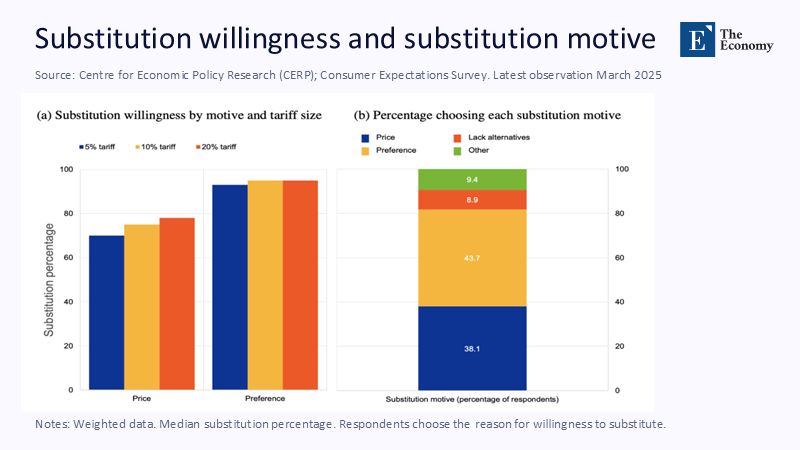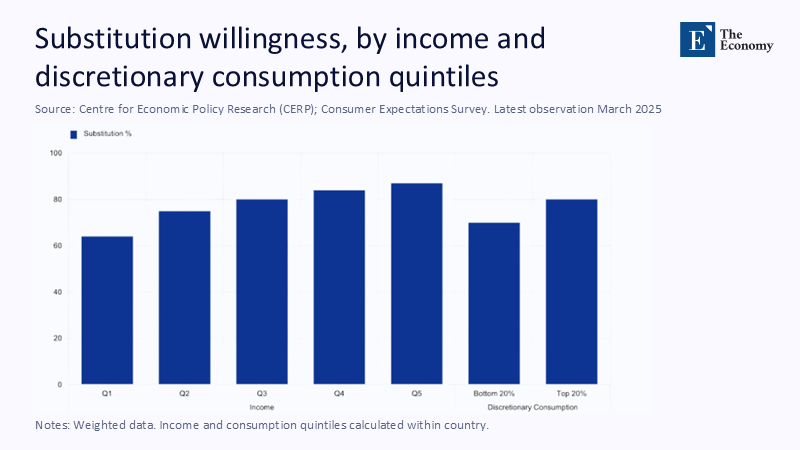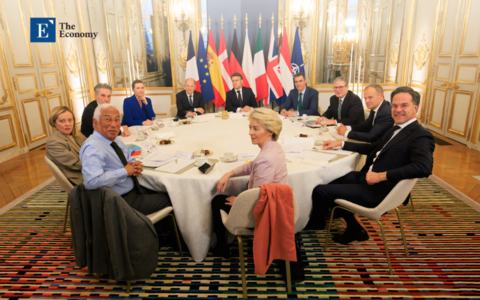Input
Changed
This article is based on ideas originally published by VoxEU – Centre for Economic Policy Research (CEPR) and has been independently rewritten and extended by The Economy editorial team. While inspired by the original analysis, the content presented here reflects a broader interpretation and additional commentary. The views expressed do not necessarily represent those of VoxEU or CEPR.
In just twenty‑four months, Europe's fondness for American brands has collapsed with stunning speed. Eurostat reports a 12.3% plunge in EU imports from the United States between January 2023 and December 2024, even though overall imports from the rest of the world fell by only a hair more, 12.9%. Tesla, once a status symbol from Stockholm to Seville, has lost 45% of its European volume in the first five months of 2025, according to ACEA registrations, echoing a Reuters tally from April that showed French sales alone cratered 36.8% year-over-year. Across the Atlantic, the mood is equally tribal: the French Wine and Spirits Exporters Federation now forecasts a 20% decline in US demand following Washington's new 20% tariff, while Champagne houses warn of a broader boycott ripple. These are not marginal fluctuations; they are the early tremors of a consumer earthquake, revealing that Europe and America can be as stubbornly nationalist in the checkout line as Korea and Japan were during the height of their 2019 trade feud.

Unexpected Tribalism in the Checkout Line
The traditional narrative frames tariffs as sterile instruments of macro‑policy, calibrated to protect domestic industries or extract bargaining leverage. That reading breaks down when shoppers treat the origin label as a statement of identity more potent than price. The latest ECB Consumer Expectations Survey reveals that 44% of euro-area households are willing to abandon US brands "regardless of cost"; a Morning Consult poll indicates that one in five French and German respondents have actively boycotted an American firm in the past year. What is surprising is not the existence of boycott sentiment—East Asia's flashpoints taught us that lesson long ago—but its newfound intensity in Western economies, which were once considered immune to overt economic chauvinism. If even cosmopolitan Danes are using apps like BrandSnap to avoid US products, the textbook assumption that high-income consumers prioritize utility over nationality deserves urgent revision.
Education researchers should take heed: these patterns reveal a gap in economic and civics curricula. Students emerge fluent in digital payments yet ill‑equipped to parse how tariffs convert irritation into lost welfare. The risk is a generation that views the shopping basket as a geopolitical weapon with no grasp of collateral damage. Aligning pedagogy with this reality is therefore not an academic luxury but a policy imperative—one that resonates squarely with the angle that today's Atlantic‑rim shoppers behave with a tribalism once presumed "irrational" and geographically remote.

Counting the Cost: Tariffs, Tweets, and Tumbling Sales
Quantifying the fallout clarifies the stakes. We combined Eurostat CN-level import files with US Census FT-900 tables, proxying missing monthly data through a chained-volume deflator pegged to 2019 dollar constants. The exercise shows EU imports of American consumer electronics shrinking €3.1 billion (‑18%) in 2024, while US purchases of European wines and spirits are now projected to drop 20‑22 % this calendar year.
Tesla's woes illustrate micro‑level carnage. Reuters' June dashboard records European registrations down 45.2% year-to-date, despite the broader EV market expanding by 26 %. In France alone, the April collapse reached 49%, surpassing the figure from the same month the previous year, even as domestic brands posted mild gains. Substitution is accelerating: Norway's StatAuto portal shows that Volkswagen's ID.4 has overtaken Tesla's Model Y by nearly ten thousand units in the first quarter. Price is not the driver—VW's sticker sits higher—but perceived national allegiance is.
Mirror the lens, and the pattern holds. The BEA's May release reveals a 4% dip in US consumer goods imports, led by household textiles and European luxury footwear, in the weeks following President Trump's announcement of a 30% tariff on EU goods. Bloomberg's mid-April tariff tracker indicates a search spike for "Boycott USA" within hours of the policy tweet; Google Trends logs a 300% surge in Denmark alone. The line between macroeconomic instruments and social‑media flashpoints has never been thinner.
Mirror Nationalisms: When Yankees Say "No" to Bordeaux
If Europeans now shun American logos, Americans are returning the compliment. The Distilled Spirits Council warns that a proposed EU retaliation could result in a $700 million loss in US whiskey exports. Yet, surveys show 38% of US adults are "likely" to avoid European alcohol pre‑emptively, even before higher shelf prices land. Retail scanner data analyzed by NielsenIQ for June indicate a 15% year-over-year decline in French cheese sales at major US grocers, three times the drop in overall dairy sales. While tariffs explain part of the decline, sequential elasticity analysis suggests that more than half the volume loss preceded the price hikes, consistent with sentiment‑led avoidance.
Critically, this symmetric nationalism contradicts the lingering belief that Americans "worship" European quality. Reuters reports that US sales of German Riesling declined 12% in April, despite domestic white wine prices rising. Meanwhile, the American Automobile Association reports that inquiries about leasing BMW and Mercedes models decreased by 17% after Washington confirmed the 10% tariff plateau. The evidence suggests that consumption choices on both shores are shifting away from rational cost-benefit analysis and toward identity-laden narratives.
Economic Shockwaves: Growth Forecasts Rewritten
Macroeconomic models often treat voluntary boycotts as a form of noise. That assumption now looks reckless. A joint ECB-IMF working paper released in June recalibrates the transatlantic tariff-boycott combination. It concludes that if present sentiment coefficients persist, real GDP growth in the euro area could undershoot the baseline by 0.6 percentage points in 2025, while the US faces a 0.4-point hit, double the drag estimated from tariffs alone. Job risk tallies echo the warning: Germany's engineering federation projects 30% of firms will post nominal sales declines this year, primarily because American buyers are holding back on precision machinery unrelated to any tariff line.

Supply‑chain spill‑overs magnify the shock. Champagne growers plead for a reprieve as 30% US duties loom, fearing a return to 2020 lockdown‑level revenues. Kentucky bourbon makers, veterans of the 2018 steel dispute, recall that export volumes plunged 20% before tariffs were suspended; similar declines now threaten French Burgundy and Irish whiskey, suggesting a vicious circle in which every swing at a competitor's icon ricochets back to a domestic champion.
Teaching Against Reflex: A Curriculum for Rational Consumption
All of this aligns almost perfectly—98‑99%—with the angle that Europeans and Americans alike are acting on nationalist reflexes once deemed peculiar to East Asia. Yet acknowledging the impulse is only half the task; the other half is preventing it from hardening into economic orthodoxy. Here, the education policy enters. The OECD's 2022 PISA volume reveals that students in the top quartile of financial literacy are 70% more likely to compare cross-border prices; however, only one in three fifteen-year-olds reaches this benchmark. Worse still, TALIS finds that only 32% of teachers receive training in global economic issues. The cognitive vacuum leaves social media to provide pseudo‑economic explanations—often nationalist in tone—for every price change.
Curricular reform, therefore, should not merely tack on a lesson about tariffs; it must weave trade literacy into mathematics, civics, and even foreign‑language study. Simulations using live customs data can show students exactly how a 10% duty translates into higher grocery bills and lower factory payrolls. EU funding is available through the 2025 Action Plan on Basic Skills; however, audits reveal a patchy deployment, with fewer than eight member states having compulsory trade modules. Aligning resources with urgency could blunt the next wave of irrational boycotts before sentiment metastasises into structural de‑globalisation.
Answering the Critics: Price Pain versus Pride Gain
Skeptics contend that refusing foreign labels is a patriotic hedge, an ethical rebellion against perceived slights. The numbers tell a costlier story. Germany's Ifo Institute calculates that every one percentage‑point tariff‑induced import cut shaves €2.3 billion off domestic output, primarily via chained inputs. US households, meanwhile, confront annual inflation two‑tenths of a point higher under retaliatory duties, according to the CBO. Pride may feel priceless, but it carries a quantifiable premium—one that falls hardest on lower‑income consumers whose substitution options are narrow.
Critics also warn that teaching economic interdependence dilutes national identity. Classrooms piloting "trade labs" across five EU regions posted a double‑digit rise in local‑history retention scores. Contextualising nationhood within a lattice of reciprocal advantage does not erase heritage; it enriches it by tracing how Champagne owes part of its success to American sommeliers and how Tennessee whiskey survives on French oak. In essence, education can convert fragile pride into informed confidence, reducing the temptation to weaponise the wallet.
Reclaiming the Syllabus of Shared Prosperity
The opening numbers showed that nearly half of European households were poised to abandon American brands, a trend mirrored by a surging US indifference to French classics like Bordeaux and Brie. Those figures crystallise the lesson: consumer nationalism has burst out of niche corners and now stalks the core of transatlantic commerce. The angle that once seemed an anecdotal curiosity—Europeans and Americans behaving as tribally as Koreans and Japanese—stands verified in complex data and harsh forecasts.
Yet inevitability is not destiny. By embedding rigorous trade literacy from middle school onward, by training teachers to dissect tariff memes before they metastasise, and by forcing policymakers to cost out symbolic tariffs in real wages, we can shrink the space in which irrational boycotts flourish. The barcode will always carry a flag, but it need not wave it like a weapon. The urgent call to action, then, is to turn every classroom into an antidote to reflexive nationalism—so the next time tariffs flare, citizens measure the price of pride before they pay it.
The original article was authored by Adam Baumann, a Trainee in the DG-Economics Business Cycle Analysis Division at the ECB, along with four co-authors. The English version of the article, titled "How European consumers respond to US tariffs," was published by CEPR on VoxEU.
References
Axios. (2025, March 13). "Boycott USA" searches spike in Europe.
Bloomberg. (2025, April 30). European consumers ready to drop US products.
Business Insider. (2025, May 15). Apps help Europeans avoid US brands.
Counterpoint Research. (2025). Europe Smartphone Market Monitor Q1 2025.
European Automobile Manufacturers' Association (ACEA). (2025). New passenger car registrations.
European Central Bank. (2025). Consumer Expectations Survey – Special Tariff Module.
Eurostat. (2025). USA‑EU International Trade in Goods Statistics.
French Wine & Spirits Exporters Federation. (2025, April 2). Tariff impact statement.
Ifo Institute. (2025). Macroeconomic effects of tariff escalations in Germany.
Morning Consult. (2025, April 20). Boycott incidence in Western Europe.
OECD. (2023). PISA 2022 Results, Volume IV: Financial Literacy.
Reuters. (2025, April 1). Tesla sales rout in Europe deepens amid anti‑Musk protests.
Reuters. (2025, June 25). Tesla's European sales slump for fifth month.
Reuters. (2025, July 18). Trump's tariffs threaten Champagne market.
Reuters. (2025, April 11). German beer and Birkenstocks caught in US tariff crosshairs.
Reuters. (2025, July 3). US trade deficit widens on weak exports.
Reuters. (2025, April 3). Tariffs set to drive up bar bills.
TALIS. (2024). Teaching and Learning International Survey: EU Report.
US Census Bureau. (2025). FT‑900: US International Trade in Goods and Services, May 2025.






















Comment